A glorious Romanian lemon cake with lemon buttercream - Lamaita (Lemon Cake) or Alba ca Zapada (Snow White Cake), this layered cake is just amazing!
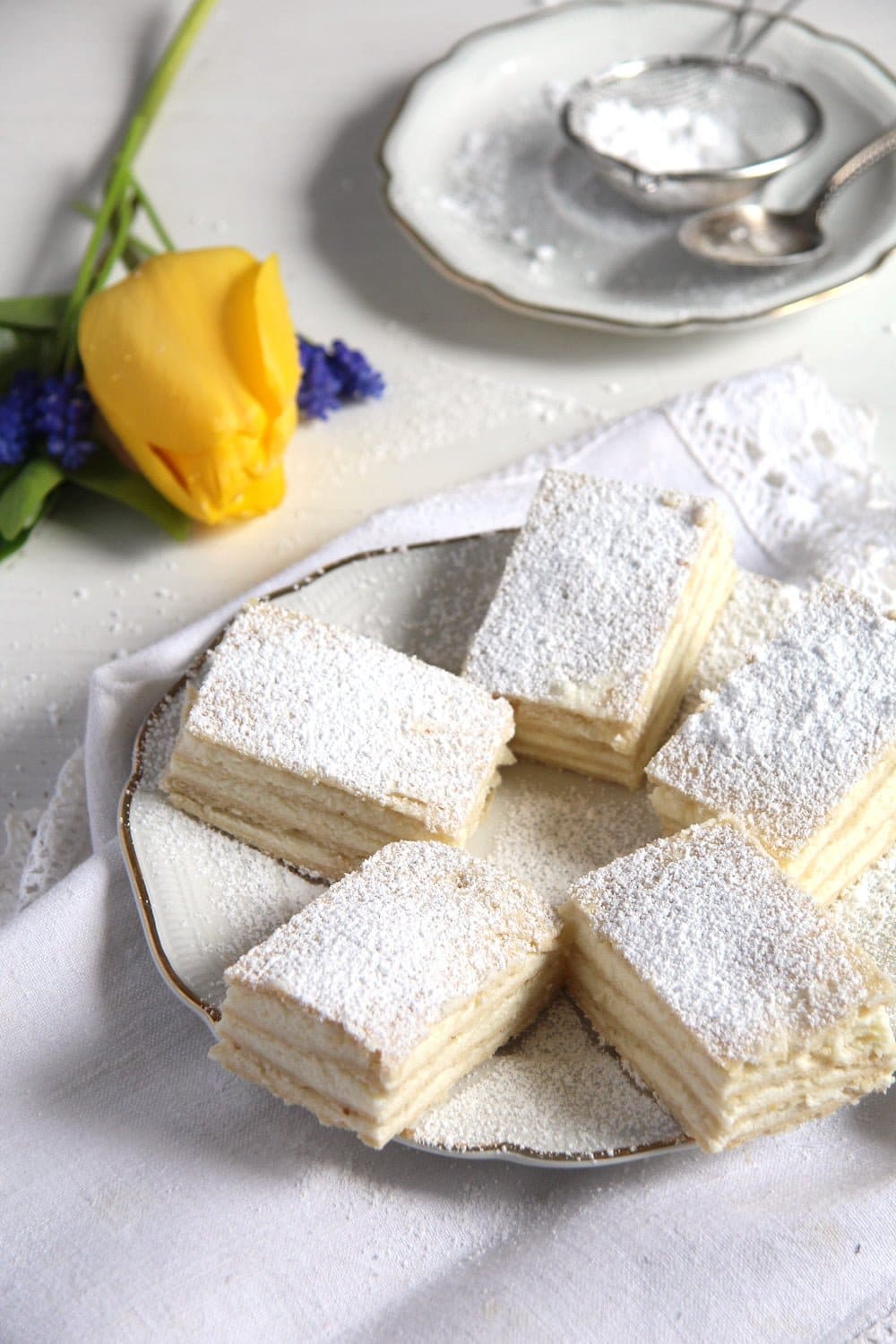
This lemon buttercream cake is one of my favorite Romanian cakes! I like lots of them, of course, but the Snow White cake has a special place in my heart.
Why? Simply because it was one of the first truly typical Romanian cakes that I've tasted and actually liked. I've mentioned it before that as a child I was not really a cake or sweets person.
There were a few choice things I liked (like the Romanian Biscuit Salami - Salam de biscuiti or Arlechin), but the list was short. And most of the time I would not even try any cake; I just assumed I would not like it and ignored it.
It was at my mother's place that I had this cake for the first time. I was already grown up, so I thought I should get over it and just give it a try. I liked it so much, I could not stop eating it for a while. We even baked it together again a few days later.
Jump to recipe
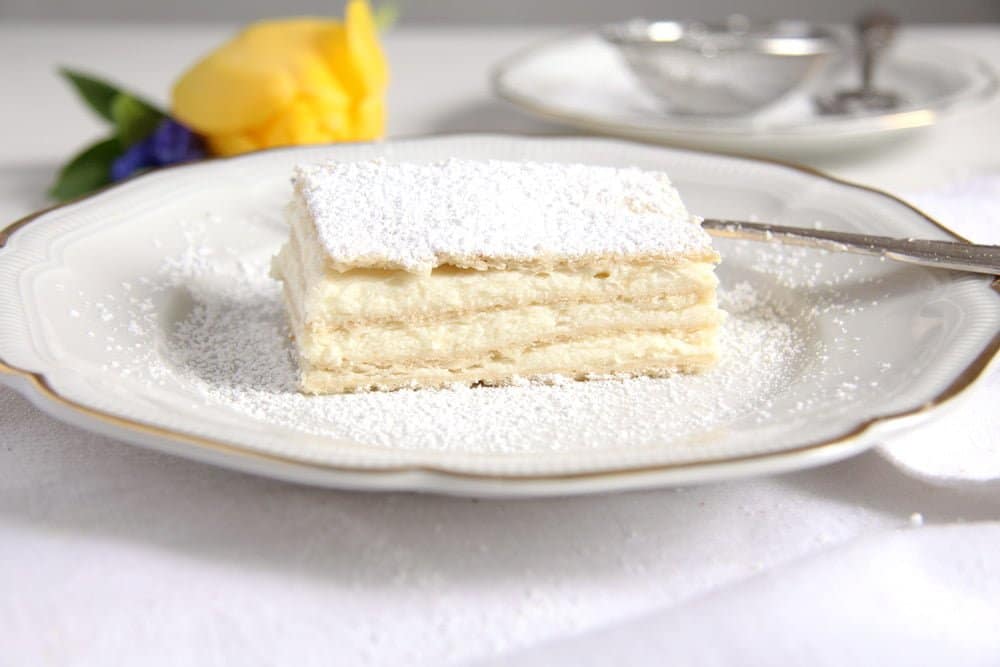
Steps and tips for making lemon buttercream
- Start with making that delicious lemon buttercream, as the pudding will need time to get completely cool before you add the butter and the lemon juice.
- To make the pudding, you will need some flour, cornstarch, sugar, and milk. The procedure is the same as when making a regular pudding. You mix the flour, cornstarch, and sugar with enough milk to obtain a thick yet pourable paste.
- In the meantime, bring the remaining milk to a boil. Slowly start pouring in the flour mixture while whisking continuously to avoid the formation of clumps.
- Let the pudding bubble for about 20 seconds while stirring, and transfer to a bowl. Cover the pudding with a piece of cling film directly over the surface; this will prevent the pudding from forming a skin.
- While the pudding is cooling, take the butter out of the refrigerator and let it come to room temperature.
- It is very important that both the pudding and the butter have the same temperature (room temperature) when you start mixing them. Otherwise, the buttercream will curdle.
- Also, make sure that you don't taste the lemon buttercream while mixing it; the spit from your fingers will also cause the buttercream to curdle.
- So, once the pudding and the butter have reached room temperature, beat the soft butter until pale and fluffy.
- Mix the pudding with the freshly squeezed lemon juice. Start with about 8 tablespoons and add the remaining juice to taste. I always add all the 10 tablespoons; I love the buttercream to be really lemony.
- Slowly start adding the pudding, one tablespoon at a time, to the butter while beating all the time. Mix well.
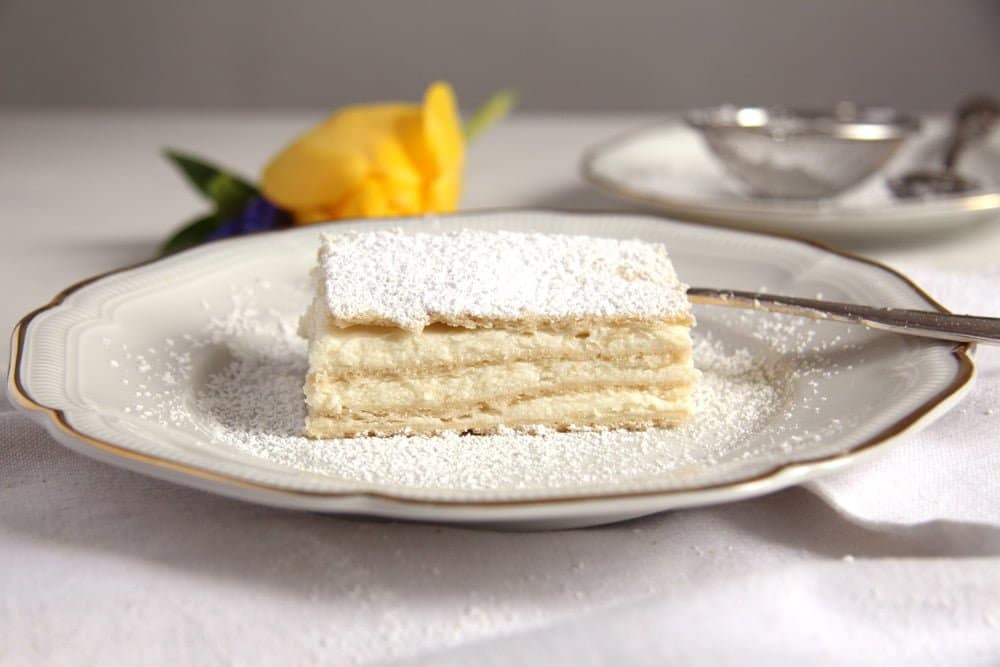
How to make the pastry layers?
- This Romanian lemon cake consists of four layers of crust held together by the creamiest, most delicious lemon buttercream filling.
- The idea of baking four layers of crust might sound difficult or time-consuming, but it is really not the case.
- The dough is rather oily, which makes it really easy to roll, and it only needs about 10 minutes in the oven, a total time of 40 minutes, which is really more or less about the time you will need when baking a regular cake base as well.
- You should make the cake layers while waiting for the pudding to cool. The cake layers will also need some time to cool, but not as long as the pudding.
Using baker's ammonia
When first publishing the layered lemon cake recipe, I used baking soda to make the crusts. I wasn't bothered by the light baking soda after-taste, but I had readers saying that the after-taste was too domineering.
I suggested the use of baker's ammonia, although I had never used that when making this particular layered lemon cake. But I knew for a fact that baker's ammonia is very popular in Romania and that my aunt uses it a lot when making cakes.
What is baker's ammonia?
The most important thing you have to know is that you should never mistake baker's ammonia with cleaning ammonia. Cleaning ammonia is poisonous!!!
Baker's ammonia or ammonium bicarbonate is what bakers used to take before the discovery of baking soda and baking powder. Those two quickly replaced the baker's ammonia in baking due to one reason: baker's ammonia stinks!! Really badly!
That is why it is best to use the baker's ammonia for making "only low-moisture baked goods like crisp cookies and crackers that thoroughly dry out during baking, lest the ammonia linger".
Once the cake layers are baked, there will be absolutely no lingering smell anymore. Nothing at all! And most importantly, there will also be no soapy-tasting after taste of baking soda or baking powder.
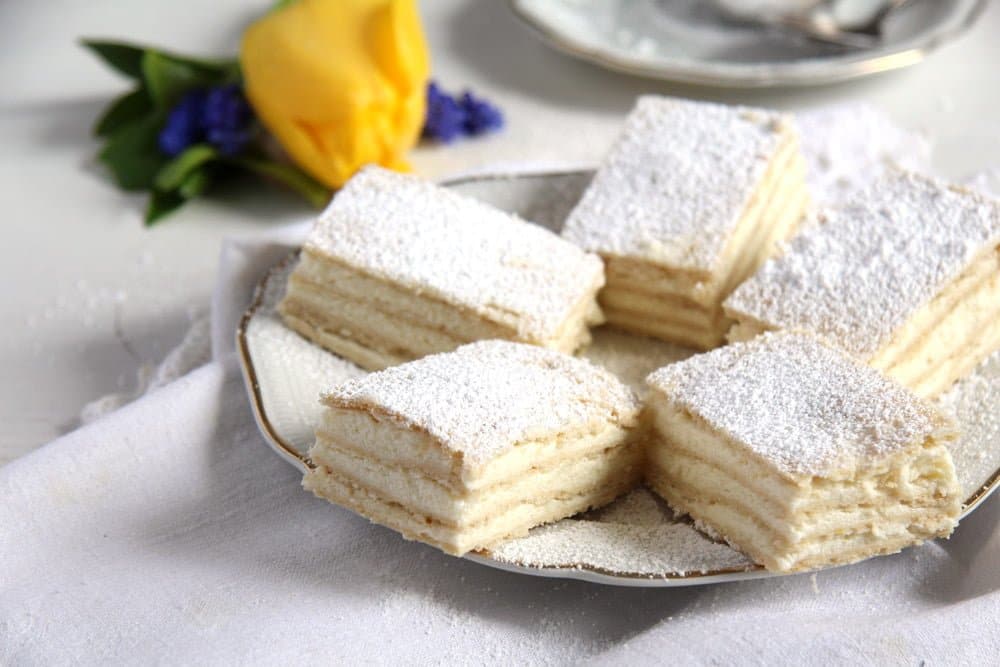
Bake and assemble
- You will have to bake the four cake layers or cake crusts on the back of a baking tin. This is a very often used technique in Romania; there are lots of layered cakes being baked this way.
- However, you can also bake the layers on a regular tray lined with baking paper, you just have to pay more attention, the layers should all have roughly the same size.
- You will only need to butter the back of the tin before baking the first layer. When baking the following layers, make sure you use oven gloves as the tin will be extremely hot.
- Roll the layers on a lightly floured surface in rectangles about the size of the tin. Transfer them to the back of the tin and roll or press the dough around to make it fit the back of the tin.
- The edges do not have to be perfect; you will cut them away anyway before slicing the cake.
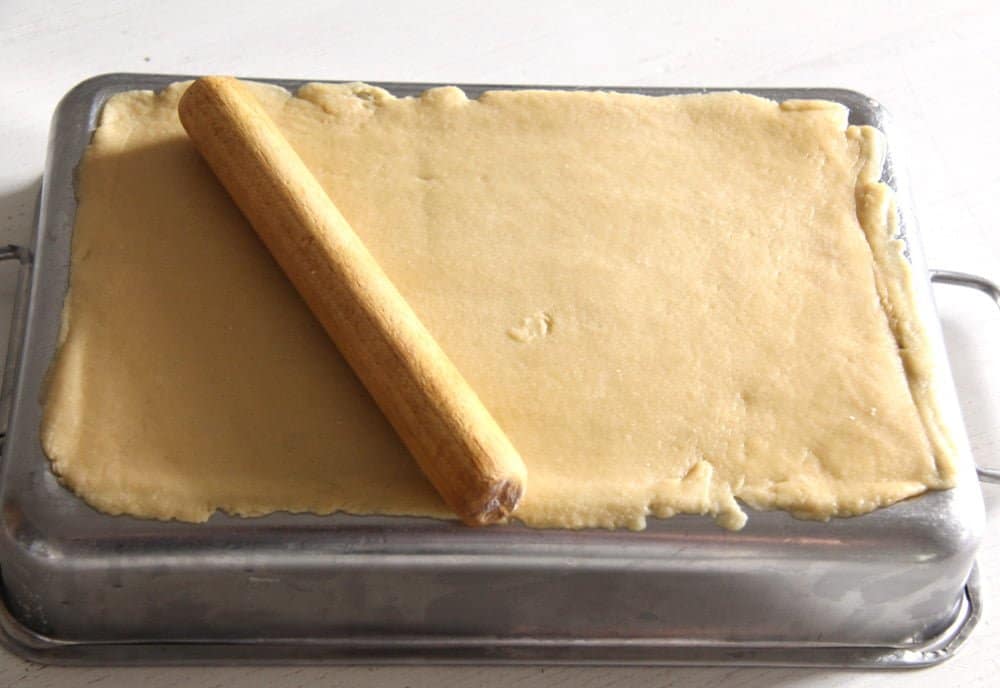
- To remove the cake crust from the back of the tin, hold the tin firmly with a gloved hand and run a long knife underneath the cake layer. It works very easily; you will not have to worry about the crust getting stuck to the tin or breaking.
- Place the ready-baked cake layers on top of each other and let them cool completely. They will not stick to each other if stored this way.
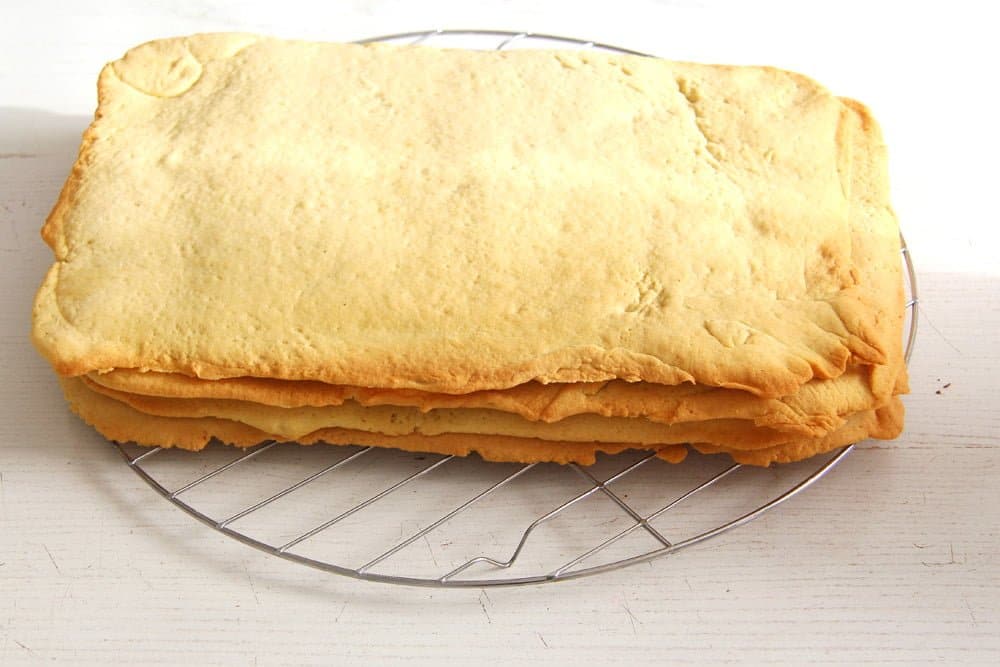
- Divide the lemon buttercream into 3 equal portions and cover 3 cake layers with the buttercream. Use the nicest-looking layer to place on top of the cake.
- Cover the cake with cling film, place in the fridge, and let it set overnight. The lemon buttercream cake needs time to become really tender and develop the flavor.
- I also recommend using European-style unsalted butter; it has a higher fat content and less water, and it tastes better when making buttercream.
- I used about 10 tablespoons of freshly squeezed lemon juice for the buttercream, which would be the juice of 2-4 lemons, depending on their size.
More Romanian cakes
Do you like this recipe?
Please leave a good rating in the recipe card below. Stay in touch through social media: Pinterest, Facebook, and Instagram. Don't forget to tag #whereismyspoon when you try a recipe!Recipe
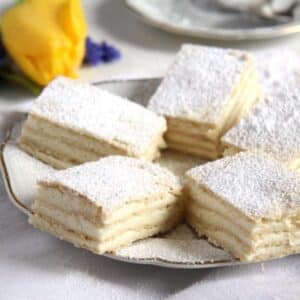
Romanian Lemon Cake (Snow White Recipe)
Ingredients
Lemon buttercream:
- 150 g/ 5.3 oz/ ¾ cups sugar
- 2 tablespoons flour
- 2 tablespoons corn starch
- 350 ml/ 11.8 fl.oz/ 1 ½ cups milk
- about 10 tablespoons freshly squeezed lemon juice to taste (Note 1)
- 200 g/ 7 oz/ ¾ cup + 1 ½ tablespoons unsalted butter soft
- icing sugar
Crust:
- 60 g/ 2.1 oz/ ⅓ cup sugar
- 2 eggs
- 100 g/ 3.5 oz/ ⅓ cup + 1 ½ tablespoons unsalted butter soft
- 1 tablespoon baker's ammonia Note 2
- 3 tablespoons milk
- 300 g/ 10.6 oz/ 2 ½ cups flour
- zest of 1 organic lemon
Instructions
- Use a kitchen scale, it guarantees for best results.
- The layered lemon cake with lemon buttercream should be made one day in advance, it needs to spend the night in the fridge in order to become really tender and develop the flavor.
Lemon buttercream:
- Place the flour, starch, and sugar into a bowl and mix with so much of the measured milk to obtain a thick yet runny paste.
- Place the remaining milk into a saucepan and bring to a boil. Slowly add the flour-sugar paste while whisking all the time. Continue whisking until the mixture thickens and comes to a boil again, that will happen very quickly.
- Let bubble for a few seconds while whisking, and remove from the heat. Transfer to a bowl and place a piece of cling film directly on top of the pudding to prevent it from getting skin and let it cool completely.
- When cool add the freshly squeezed lemon juice and stir well. Taste after adding about 8 tablespoons and continue adding until it is as tart as you like it.
- To make the buttercream, both butter and pudding have to have the same temperature, which is room temperature, otherwise, the buttercream might curdle.
- In another bowl beat the butter until pale and fluffy. Slowly start adding the lemon pudding to the butter, one tablespoon at a time. Beat until incorporated.
- Taste the buttercream again and add more lemon juice if you like it.
Cake layers:
- While the pudding for the buttercream cools, make the cake layers.
- Preheat the oven to 180 degrees Celsius/ 360 degrees Fahrenheit.
- Beat together the soft butter and the sugar until fluffy. Add the eggs and mix well.
- Mix together the baker's ammonia and the milk and incorporate that into the egg mixture.
- In another bowl mix together the flour and the grated lemon zest. Incorporate into the egg mixture. You will now have a rather oily looking dough that should not stick to your hands at all. You may add one tablespoon of extra flour if you feel it necessary, it depends on the size of your eggs if you need that extra tablespoon or not.
Roll and bake:
- Divide the dough into four equal parts. Wrap the three dough balls that still have to wait in cling film to prevent them from drying out and set them aside in a cooler place, not the fridge but also not that close to the oven.
- You will only need to butter the tin before you bake the first layer of crust.
- Roll the first dough ball into a rough rectangle on a lightly floured surface, place it on the buttered baking tin, and roll again until the dough layer is as large as the baking tin: 32x22 cm/12x9 inches approximately (or similar size, it doesn't have to be so exact). And don't stress too much about having perfectly straight edges, you will cut those away before slicing and serving the cake.
- Bake for about 10 minutes or until slightly golden around the edges. Take out of the oven and while holding one side of the tin with a gloved hand, run the blade of a long knife underneath the crust. Let it slide carefully and slowly onto a cooling rack.
- Repeat with the remaining dough balls.
- Keep in mind that the tin is now very hot, don't touch it when rolling the dough on top, and use gloves when you transfer it to the oven.
- When the crust layers are baked, you can carefully staple them one on top of the other, they will not stick. Let them cool completely.
Assemble:
- Divide the filling into three portions. Reserve the best looking crust for the top of the cake.
- Place one crust on a serving plate and top it evenly with one portion of the buttercream.
- Place the second crust layer on top, press gently then cover it with the second buttercream portion.
- Repeat one more time.
- Place the reserved crust layer on top, press gently again, and cover the cake with cling film.
- Place in the fridge for several hours or better overnight.
- Cut the rough edges (and eat them), then cut the cake into small rectangles. Dust with icing sugar shortly before serving.
Notes
- I used about 10 tablespoons of freshly squeezed lemon juice for the buttercream, that would be the juice of 2-4 lemons, depending on their size. I like the buttercream to be really tart, that strong lemon flavor is the best thing, but you should start tasting after adding about 8 tablespoons and decide yourself if you want more or not.
- Baker's ammonia or ammonium bicarbonate should not be confused with cleaning ammonia, which is poisonous.

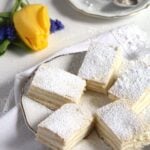
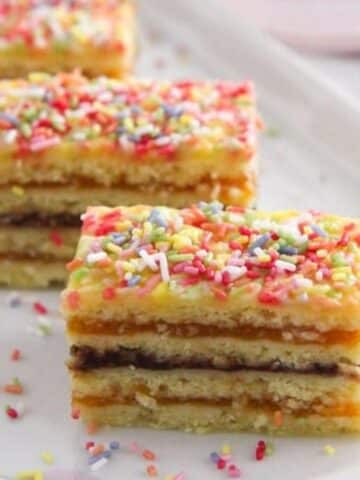
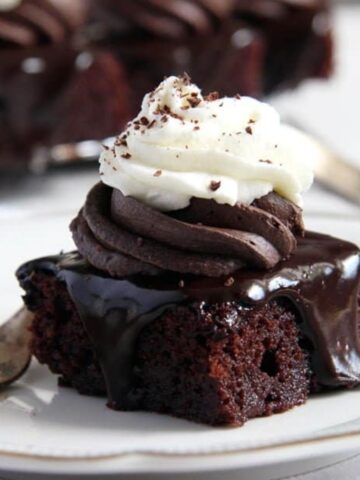
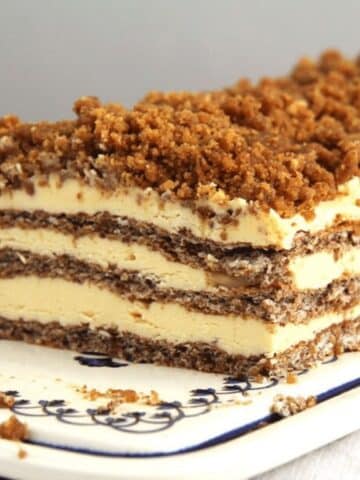
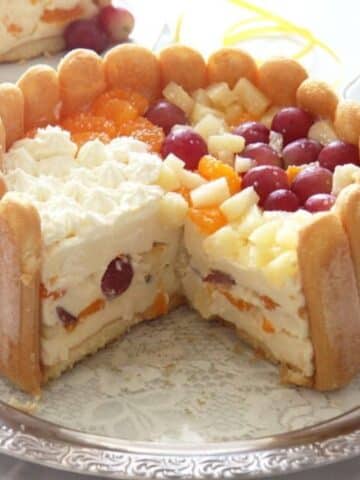
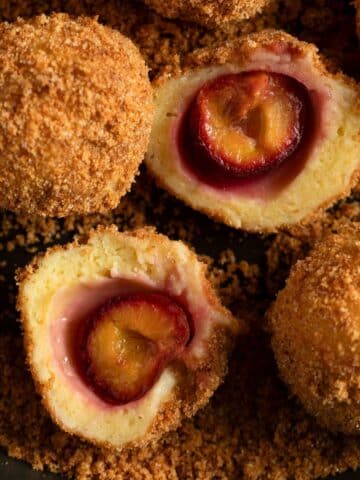
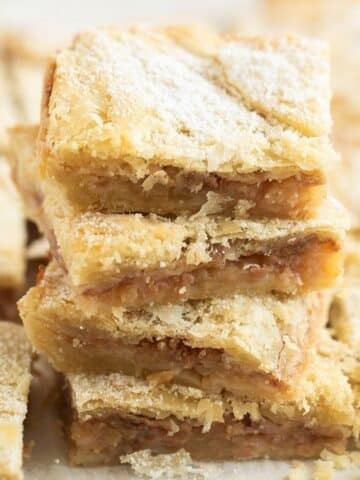
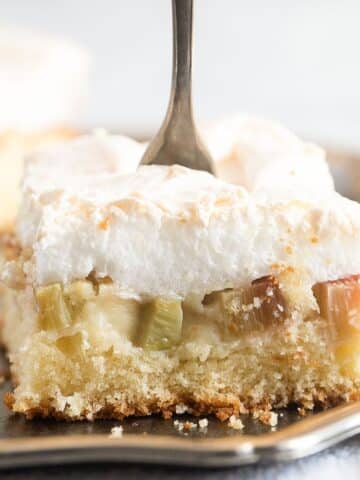
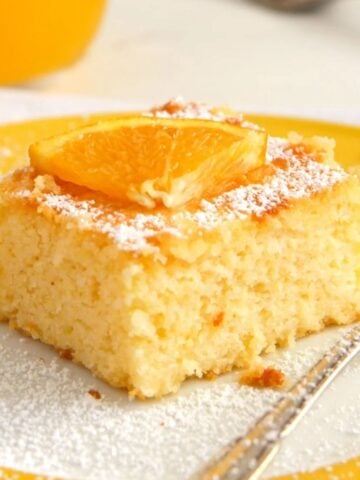

mae says
it is good but it takes a very very long time and a lot of commitment
Julie says
Hi there! Under the cream ingredients there it calls for icing sugar but does tell you how much or what to do with it?
Adina says
Hi Julie. Icing sugar is just for decorating the cake, I should have listed it at the end of the ingredient list. Use as much as you need to make the cake look nice, about 1 tablespoon I suppose.
Ri says
Hi, Adina. Do you measure everything in grams or you use cups while preparing?
Adina says
Hi Ri. I always use a scale, it is so much more reliable than cup measuring. Well, unless I am following an original American recipe, which only mentions cups.
nicole (thespicetrain.com) says
Such beautifully delicate layers, this cake looks and sounds incredible, thank you for sharing, Adina! 🙂
Allie @ Through Her Looking Glass says
Dear Adina, Happy New Year my friend!!! I trust it has been busy there as it has been here with the holidays. So nice to spend time with family and now it's time to get back in the groove. This delicate cake is amazing, your instructions even more so. Glad to know not to lick my fingers making the buttercream - as that will be a great temptation for me!!! Step by step, I feel like I could easily make this cake. The layers do really well on the back of a pan, I've never used a pan for baking like that. All so interesting. I will have to see if they carry baker's ammonia around here in New Hampshire. I've never seen it, but of course I wasn't looking. lol. Adina, wishing you a GREAT year and wonderful success in all you do in 2019. XOXO
Adina says
Thank you, Allie, I wish you a great year to!
Nicky B says
Did you ever find Baker's Ammonia in NH? I also live there and have called a few stores without good results. I'm planning on ordering it online
Thao @ In Good Flavor says
For a child who wasn't a fan of sweets, you make some of the most tastiest looking desserts as an adult! This cake looks amazing! I think I would find it hard to stop eating it too!! Happy New Year!!
Adina says
Thank you, Thao. All the best for you this year!
Karen (Back Road Journal) says
If a dessert has lemon in it, I know I will like it. In this case, I know I will love your cake...it sounds wonderful.
Adina says
I love anything with lemon too, Karen. ?
Aideen says
Thank you for the recipe but did you really mean 1 tablespoon of baking soda? The pastry tasted so strongly of baking soda I couldn't eat it!
Should the recipe say 1 teaspoon instead?
Adina says
Hi Aideen. I am so sorry about the baking soda taste. I've just checked the recipe again and it is 1 tablespoon baking soda, I did not have any problems with it, I've made this cake quite a few times... I don't know exactly, but sometimes the products differ from brand to brand and from country to country. I know for sure that that is the case with baking powder, the one we use here is a bit different than the American one and depending on the cake you make that might be an issue or not. I didn't find any certain information on baking soda though. What I could recommend you to try is to use baking ammonia instead (not to be confused with cleaning ammonia, which is poisonous!!!!) The baking ammonia has quite a strong smell but when used to make thin pastry (like in this case) or cookies, the smell will not linger. And you can be sure that the cake will not taste of baking soda. I know what to you mean by it, I had that in other cakes before, but really not in this one, I have always made with baking soda and there was never a lingering taste.
Aideen says
Hi Adina Thank you for your quick reply! I will try that instead this time. I want to make it again, the lemon cream was so good.
Brie says
You had me at 10 tablespoons of lemon juice! All of your cakes are so gorgeous Adina but this one is a real stunner. I can just imagine each bite with all of that tangy buttercream and buttery crust layers.
Love your tip in the directions about the proper way to dispose of cake off-cuts 😉
grace says
you make an awesome layer cake, adina! i love it when the filling outweighs the cake. 🙂 love the name too!
KR says
lemon sounds delicious!! Thank you for sharing this recipe, it look so watermouthing, and if I think about lemon... this is more watermouthing 🙂 🙂
This is cake I must try for sure 🙂
mjskitchen says
OMG! I LOVE lemon desserts and any dessert with 10 Tbsp. of lemon has got to be absolutely amazing! It looks beautiful, so beautiful and delicious that I'm tempted to lick the screen and dream. My mother made great desserts, but never anything this fancy. YUM!
Anca says
Aww, this was one of my favourite desserts as a child. My mother used to call it Alba ca Zapada, I only recently heard about Lamaita. 🙂 I don't think I ever baked one though. I should give it a try.
Alina says
Yay, so happy you posted this recipe! I never tried to make this cake before, probably because no one in my family had the recipe. I think I tried it once at a local bakery, but I'm sure that it will taste much better if it's homemade. I also thought that baking the sheets would be time-consuming, and that's the reason why I never tried baking sheets on the back of the tray, even if they're used for many Romanian cakes. I hope I'll get to make it soon, but first I want to try some strawberry desserts 🙂 I'll send you pics when I try it. Kisses and thanks for the recipe!
Angie@Angie's Recipes says
Love the layers! The thin, crisp, buttery crust and tangy sweet lemon cream are a dream team..heavenly!